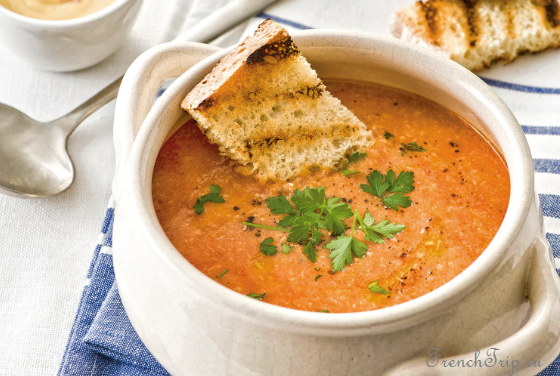Traditional Corsican dishes
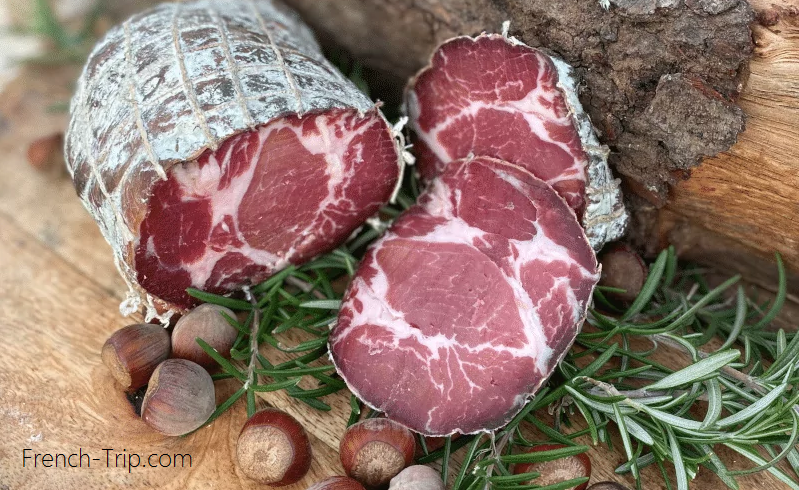
Traditional Corsican dishes are wholesome and simple. Corsican cuisine primarily features chestnuts, sausages, cheese, wild boar, and veal. This meat-centric menu is surprising for an island in the Mediterranean. Perhaps the signature dish of Corsica is civet de sanglier, a hearty wild boar stew cooked with onions, carrots, fennel, red wine, and (naturally) chestnuts.
Key Ingredients of Corsican Cuisine
Corsican staples are highly revered, including sheep and goat cheese, as well as excellent jams, honey, and olive oil.
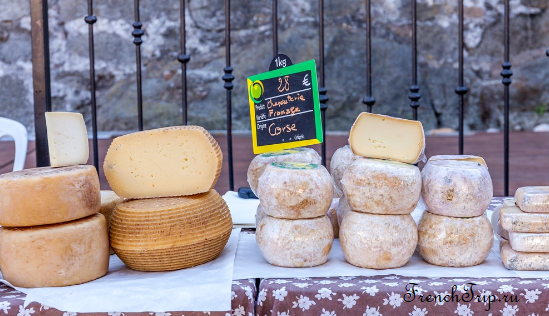
Traditional Corsican Dishes:
Corsican Soups
Soups (minestre) are an important part of Corsican cuisine.
- Minestre, or zuppa corsa, similar to Italian minestrone, is a soup with beans, potatoes, garlic, onions, mangelwurzel, cabbage, and tomatoes, with fat from a ham bone.
- Minestra di pane cotto (bread soup), similar to Italian pancotto.
- Minestra di casgiu frescu – soup with fresh brocciu cheese from Carpineto.
- Minestra di brocciu seccu – soup with aged brocciu cheese.
- Minestra di fasgiolu e di porri – soup with red beans and leeks from Niolo.
- On Holy Thursday, meat is replaced with chickpeas in minestra incu i ceci di Iovi Santu.
- Stufatu, a soup whose main ingredient is either wheat flour (stufatu di farin’di granu) or cornmeal (stufatu di farin’di granonu).
- Brilluli – a porridge made from chestnut flour, water, and goat milk.
Meat Dishes
Wild boar is perhaps the most famous dish on the island – look for sanglier on menus. Meat dishes are often served with pasta or polenta.
Civet de sanglier (wild boar stew)
This is a rich, hearty stew with the “playful” taste of wild boar, stewed with onions, carrots, garlic, chestnuts, fennel, and a generous amount of sauce, with red wine being a key ingredient. The boar, a symbolic animal of Corsica, requires extensive preparation and delicate cooking. The meat is marinated in a red wine and brandy marinade with carrots and shallots for 24 hours. The next day, it takes two hours to cook, after which the tender stew can be served with pasta or potatoes.
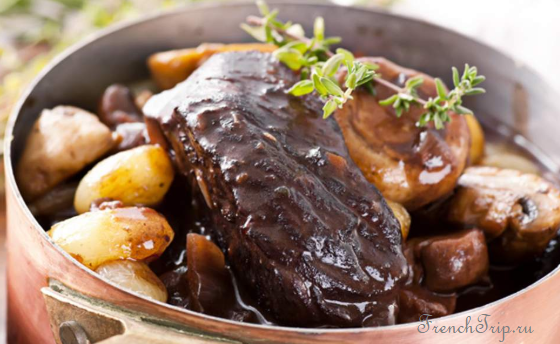
Veau aux olives (veal with olives)
A popular slow-cooked stew with tender veal, olives, tomatoes, onions, and herbs from the maquis, generously portioned with white or rosé wine.
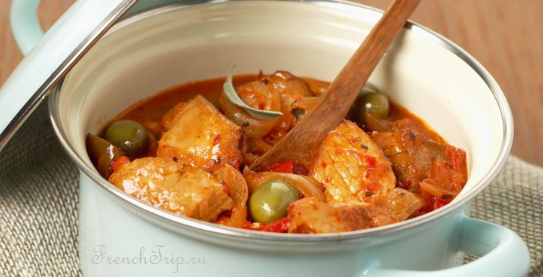
Agneau Corse (Corsican lamb)
Typically slow-roasted lamb with whole garlic cloves, fresh rosemary, and potatoes. This traditional Corsican dish rarely needs accompaniment!
Piverunata, or lamb stew
This stew with lamb or kid is traditionally prepared during the Easter holidays. The recipe originated in Corte in 1821, during Lord Byron’s stay with the Shelleys. Locals served them this typical Corsican dish made from lamb, pancetta, peppers, and onions, stewed in tomato sauce and red wine.
Corsican Fish Dishes
On the Corsican coast, you’ll find a good selection of fish and seafood, though due to the declining fish stocks in the Mediterranean, prices are quite high now. Look for red mullet (Rouget), sea bream (loup de mer), and crayfish (langoustine). Oysters (huitres) are particularly recommended in the east, and trout, caught in unpolluted rivers, is a good alternative to meat inland.
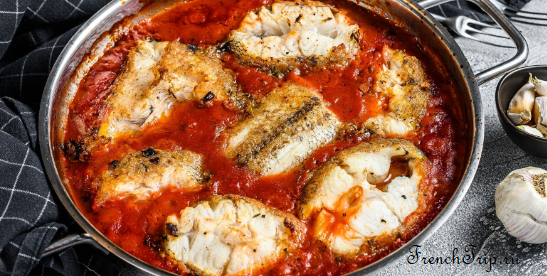
Morue-a-la-Bastiaise
Typical dishes include fish soup with sea fish (azziminu di Capicorsu) or river fish (azziminu di Corte). From the Genoese (and centuries of contact with Tuscany and Rome) come dishes based on cod and dried fish: the former can be fried (fritelle di baccalà) or – a recipe from the Genoese colony of Bonifacio – with chard and raisins (baccalà incue e l’uva secca), while the latter is prepared with tomatoes, anchovies, and walnuts in a dish called u pestu.
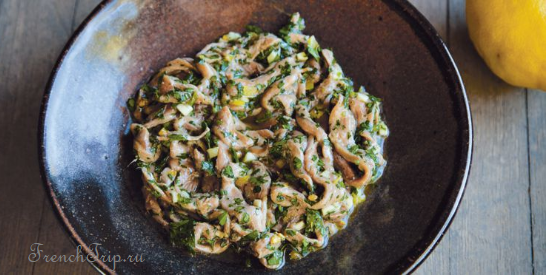
Filets d Anchois a la Bastiaise
The national cheese, brocciu, is also used with fish in dishes such as sardines stuffed with brocciu (truite piene incu u brocciu) or a pie with anchovies and brocciu cheese (torta d’anchjuve e di brocciu).
The large lagoons along the eastern coast (such as Étang de Biguglia and Diana) produce eels, served fried (anguilla arustita) or stewed (tianu d’anguila).
Mountain rivers provide abundant trout: it is consumed, stuffed with brocciu cheese (truite piene incu u brocciu), or simply fried on hot stones (truite annant’a petre fiuminalinche).
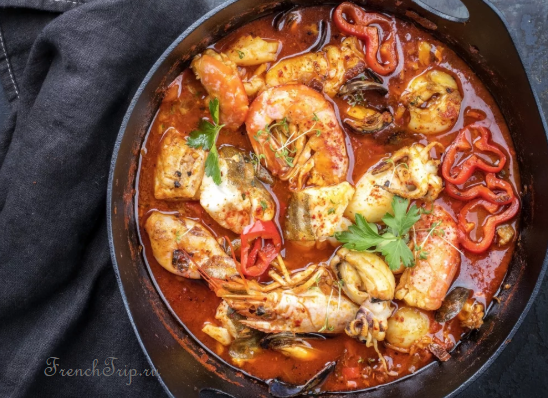
azziminu di Capicorsu
Vegetable Dishes
Corsican cuisine, similar to other Mediterranean dishes, offers several options for stuffed vegetables (ripieni), with the stuffing always being brocciu cheese: artichokes (artichjocchi pieni) and zucchini (zucchine piene incu u brocciu), eggplants (from Porto-Vecchio and Sartène) (mirizani pieni), onions (civolle piene incu u brocciu).
Vegetarian stews are also popular, such as those with fava beans (tianu di fave fresche) or with red beans and leeks (tianu di fasgioli e porri).
Sciacci are shortbread cookies with potatoes and grated cheese.
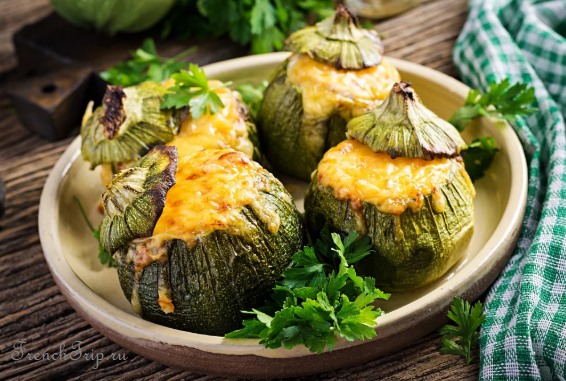
Courgettes farcies au brocciu
Pasta and Polenta
Pasta dishes illustrate the Italian influence on Corsican cuisine. Especially popular are stuffed pasta, such as ravioli and cannelloni, both filled with brocciu cheese, similar to Italian ricotta, with ravioli often accompanied by spinach.
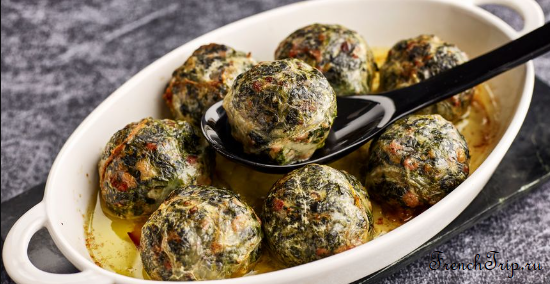
Storzapretti à la bastiaise
The sauce for pasta with tomatoes and minced meat (Salsa pe a pastasciutta) is also typical of Corsica. Other recipes reflect Italian tradition:
- Storzapretti (literally “priest chokers”) – large dumplings baked in the oven, made from brocciu and spinach, similar to the Italian version of the dish.
- Panizzi – fritters made from chickpea flour, similar to Sicilian panelle.
- Also popular are lasagna and gnocchi with meat sauce (lasagne incu a salsa and Gnocchi manera bastiaccia).
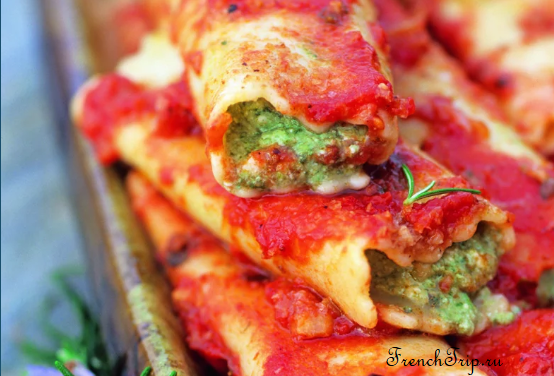
Canelloni
Although corn polenta is known in many places, in Corsica it is made with chestnut flour, pulenta castagnina. Another dish whose main ingredient is chestnut flour is Maccaredda, pancakes fried with pancetta.
- Razighe, from Rusio, are thin pancakes made from wheat flour, yeast, eggs, and pork cracklings (a byproduct of processing sdruttu).
- Migliacci – unsweetened pancakes made from wheat flour, yeast, whey, goat and sheep cheese, baked on chestnut leaves.

Migliacci
Corsican Desserts
Traditional Corsican cakes and sweets often combine two local ingredients: chestnut flour and brocciu cheese. Almost everything is stuffed with this simple fresh cheese, similar to Italian ricotta. You will find ravioli and cannelloni stuffed with brocciu in almost every menu.
Corsicans also love doughnuts and cookies. You can find freshly made canestri (doughnuts made with flour, butter, eggs, and sugar) in any respectable bakery and biscuit factory, and surprisingly, in the most remote villages.
Corsican nougat is also a popular sweet.
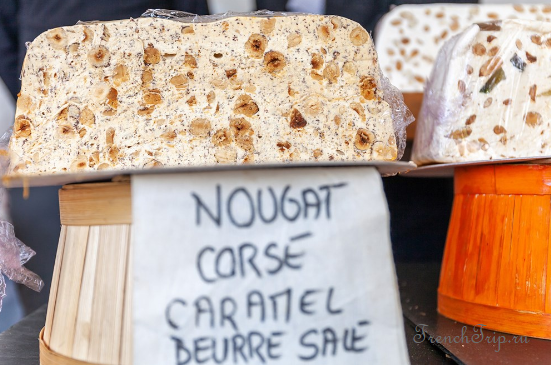
Most traditional corsican desserts are based on milk or eggs:
- Beignets – doughnuts made from chestnut flour, sometimes stuffed with brocciu cheese.
- Fiadone – essentially a cheesecake with a twist! Fiadone is a traditional recipe using Corsican brocciu cheese, eggs, and chestnut flour, then flavored with lemon zest and a sauce made from water. Usually served chilled, it is a delightful end to dinner.
- Flan a la farine de chataigne (chestnut pie) – a very simple but tasty dessert, combining the main ingredients of a typical Corsican recipe – chestnuts, eggs, and vodka.
- Cacavellu, from the village of Vico, is a round cake made from wheat flour, yeast, eggs, and sdruttu dough, decorated with brocciu cheese mixed with sugar, orange zest, and eggs.
- Cucciole – this dessert from the Balagne region (villages of Sant’Antonino, Pigna, Corbara) is a cookie made from flour, butter, sugar, and white wine.
- Castagnacciu, a simple Italian cake consisting only of chestnut flour, raisins, and walnuts, is popular in Corsica.
- Nicci – Also made with chestnut flour, nicci are pancakes cooked in a fireplace between two iron plates (i ferri), very popular also in central Italy.
- Frappe – fried diamond-shaped dough pieces, flavored with lemon zest, similar to Italian castagnola.
Fiadone
Fiadone is a magnificent classic among Corsican desserts. This delicious custard is made from brocciu, a fresh goat or sheep cheese typical of the island. Its delicate and light texture, along with its sweet lemon aroma, makes this dessert a must-have for family meals.
Fiadone includes small versions with a puff pastry base.
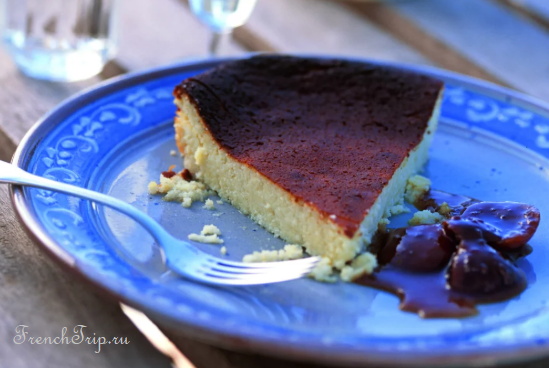
Beignets
Beignets — Lemon Doughnuts Incredibly light and fluffy, these little doughnuts are a true Corsican specialty! They’re made with brocciu, the iconic fresh cheese from Corsica, which is mixed with flour, milk, egg, yeast, sugar, and then with lemon juice and zest, giving them a delightful aroma.

Canistrelli
This dry and crumbly sweet cookie is a traditional Corsican treat, similar to the Italian Canestrelli. They’re often served with coffee, ice cream, or as a snack. Canistrelli are made from wheat or chestnut flour, sugar, and white wine. Some versions are flavored with lemon or anise, while others may include hazelnuts, almonds, or chocolate chips.
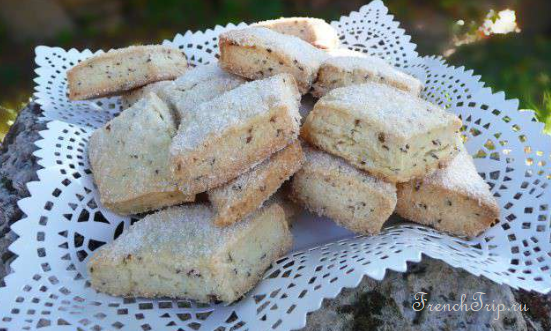
Falculelle from Corte
This warm or cold snack mix combines the creaminess of brocciu goat cheese with a pasta flavored with orange zest and lemon peel. Falculelle comes as golden-brown crackers, baked on chestnut leaves and dusted with powdered sugar. This tasty dessert is a specialty of northern Corsica.
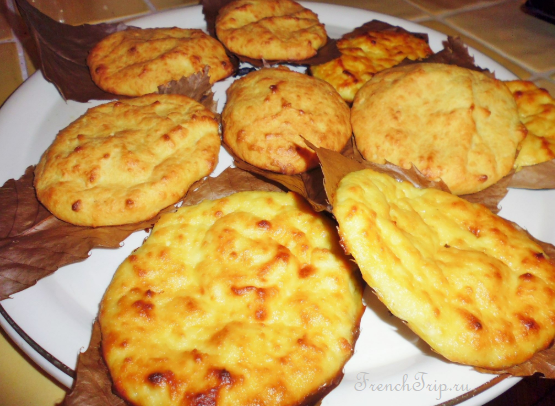
Castagnacciù: Corsican Chestnut Cake
The traditional Corsican castagnacciù is a gluten-free cake made with chestnut cream, chestnut flour, natural chestnuts, pine nuts, and rum—a unique and delicious dessert! To prepare, melt butter in a saucepan. Beat chestnut cream with 2 egg yolks, gradually adding melted butter, flour, and baking powder. Once the batter is smooth, let it rest at room temperature. Whisk eggs with sugar over a double boiler until the mixture doubles in volume. Crush chestnuts into a baking dish, pour in the batter, and bake for 30 minutes. Toast pine nuts in a pan, mix rum with water and powdered sugar, and cover the baked cake with this glaze, then sprinkle with nuts.
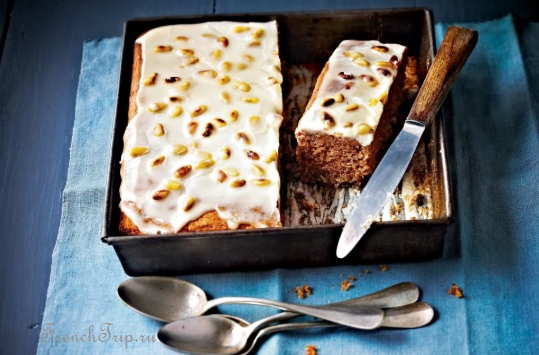
Nicci (Corsican Crepes)
Nicci are Corsican crepes made from chestnut flour. This flour gives them a characteristic dark color, resembling galettes—traditional buckwheat crepes from Brittany. Mix chestnut flour with cold, slightly salted water and let it sit for an hour. Cook the crepes between two hot plates greased with bacon. Serve with brocciu cheese, Corsican cheese, or on their own.
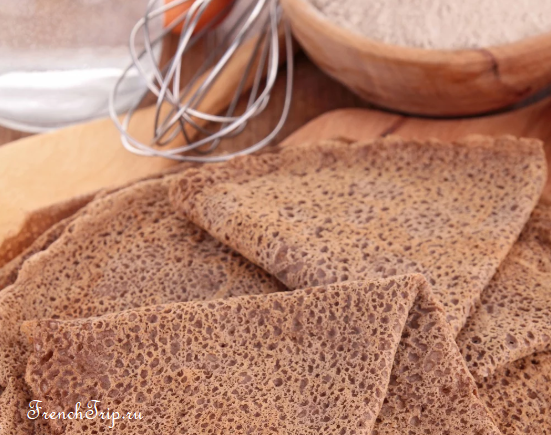
Migliacci (Brocciu Pie)
This dessert is often prepared for Easter. It is a closed pie filled with fresh brocciu cheese and yeast dough.
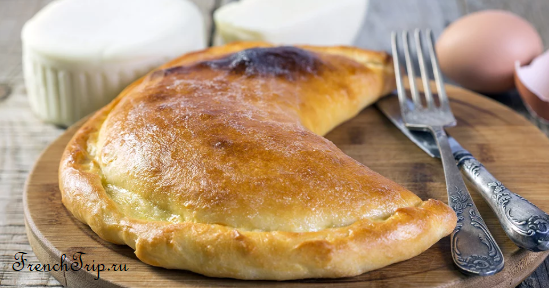
For special occasions, several cakes are prepared, some of which are characteristic of specific towns or villages:
- Strenna (a flour and dough pie with brocciu filling) is made in Vico for New Year’s.
- Panzarotti (beignets made from flour, rice, and yeast) are prepared in Bastia for Saint Joseph’s Day (March 19).
- Panette for All Saints’ Day (November 1).
- Pan di i morti (also called uga siccati, small cakes made from flour, yeast, sugar, butter, eggs, raisins, and walnuts) for All Souls’ Day (November 2) in Bonifacio.
- Canestri (doughnuts made from flour, eggs, butter, and sugar) are made for Easter.
- Campanili (doughnuts made from flour, yeast, eggs, raisins, soaked in aquavit with sugar, and decorated with boiled eggs) are made for Easter.
- Sciacci (sweet versions of these pancakes, stuffed with brocciu and traditionally cooked on a hot granite stone called teghia) are made in Sartène for Easter and during sheep shearing in May.
- Inuliata, made in Ajaccio during Holy Week, is a yeast pie containing flour, powdered sugar, olive oil, and wine.
- Fritelli, eaten on Maundy Thursday in Calenzana, are pancakes made from wheat or chestnut flour.
Corsicans also produce many types of fruit jams (confitures) made from the island’s fruits: chestnut (confitura di castagne), fig (confitura di fichi), red tomatoes (confitura di pummata rossi), strawberry (confitura d`arbitru).
A Corsican specialty is citron confit (confit d’alimea), which uses fruits grown in the Cap Corse region.
Related Links:
- Corsican Cuisine
- Corsican Wines
- Sartène Wines
- Ajaccio Wines
- Traditional Dishes of Bastia
- French Cuisine
- French Wines
Archives
Calendar
| M | T | W | T | F | S | S |
|---|---|---|---|---|---|---|
| 1 | 2 | 3 | 4 | |||
| 5 | 6 | 7 | 8 | 9 | 10 | 11 |
| 12 | 13 | 14 | 15 | 16 | 17 | 18 |
| 19 | 20 | 21 | 22 | 23 | 24 | 25 |
| 26 | 27 | 28 | 29 | 30 | 31 | |
